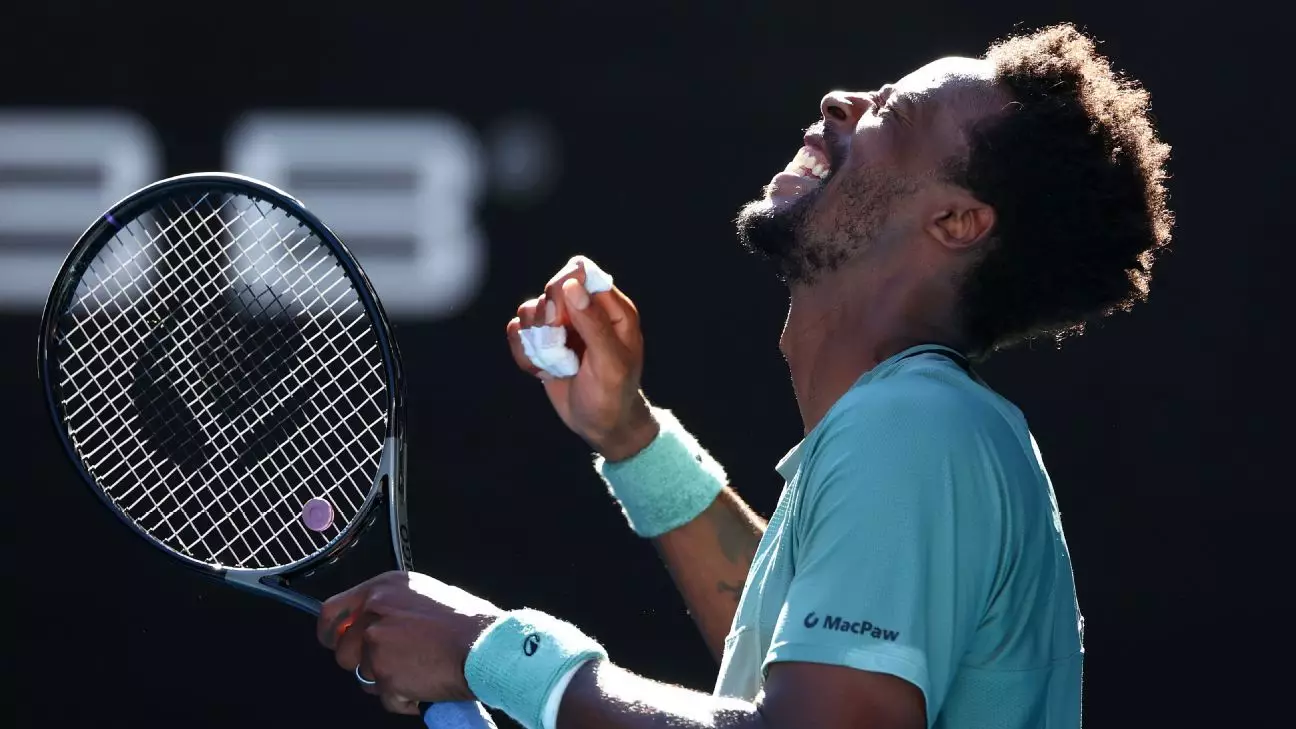The 2024 Australian Open has witnessed an electrifying display of tennis, where seasoned veteran Gael Monfils has captured the spotlight. At the venerable age of 38, Monfils has forged a remarkable path, becoming only the second man in the modern era of the Open Era—since 1988—with an expanded field of 128 players—to advance to the fourth round at this age, alongside the iconic Roger Federer. This accomplishment is not just a statistic; it symbolizes his tenacity and determination in the face of increasing athletic competition.
Monfils delivered a stunning comeback against fourth-seeded Taylor Fritz, clinching the match with scores of 3-6, 7-5, 7-6 (1), 6-4. Displaying a blend of skill and charisma, Monfils finished the match with a powerful 134 mph ace—the 24th of the match—doubling Fritz’s tally and culminating in a jubilant celebration that resonated throughout Margaret Court Arena. The atmosphere was electric, with a sea of fans waving French flags, illustrating Monfils’ status as a crowd favorite. As the fans erupted in cheers, Monfils punctured the stereotype that age diminishes athletic capability; instead, he radiated vitality and enthusiasm.
The revival of Monfils’ career began with an emotionally charged victory at a hard-court event in Auckland, New Zealand. With this title, he became the oldest male player to win a tournament since at least 1990, a feat that not only reflects his physical prowess but also his mental resilience. In his post-match comments, Monfils attributed his success to a disciplined recovery routine and an unwavering self-belief. “Every day is different; we work hard to keep improving,” he remarked, emphasizing his commitment to excellence despite the physical toll of competing against younger athletes. This mindset is not merely an individual philosophy—it’s an exemplary model for aspiring athletes who might feel overshadowed by their younger counterparts.
Monfils’ next encounter holds the prospect of significant contrast. He is set to face No. 21 seed Ben Shelton, a mere 22 years old and a recent semifinalist in the U.S. Open. This pairing accentuates the vivid narrative of generational clashes in modern tennis. Monfils will be walking into this match not just as a seasoned player, but also as a contingent of experience facing the youthful firepower embedded in Shelton’s game. The burgeoning tension between youth and experience will be a spectacle for fans, showcasing the wide-ranging narratives that a Grand Slam can produce.
Against Fritz, Monfils exhibited a breathtaking performance, achieving an impressive ratio of 58 winners against just 34 unforced errors. This winning strategy entailed effective aggression, especially with a formidable presence at the net—where he capitalized on 11 out of 15 points. Conversely, Fritz’s struggle to convert at the net—16 out of 30—underscored the tactical mastery Monfils displayed throughout the match. These metrics reveal not only Monfils’ proficiency as a player but also the evolution of his game toward a more multi-dimensional style, capable of dazzling fans and disarming opponents alike.
Monfils’ victory came as a significant relief, marking the end of a 12-match losing streak against top-five players in Grand Slam tournaments. This milestone is monumental in reaffirming his competitive spirit and reminding the tennis community of his capabilities as a formidable contender. The emotional weight of this win serves as a pivotal point in Monfils’ continuing career, injecting renewed vigor and confidence as he pushes forward in the tournament—a narrative that resonates widely among athletes facing adversity.
In an impressive coincidence, Monfils’ wife, Elina Svitolina, also showcased her own determination and skill by defeating the fourth-seeded Jasmine Paolini in a thrilling match. The shared instance of their victories on the same day adds a layer of profound personal achievement within the competitive framework of the tournament. Meanwhile, younger competitors—like Learner Tien and Alex Michelsen—are also making impressions, showcasing the diverse tapestry of talent emerging at the Australian Open. These simultaneous narratives serve to enrich the tournament’s storyline, bridging the gap between the seasoned veterans and ambitious newcomers.
Monfils’ journey at the 2024 Australian Open is an inspiring testament to resilience, skill, and the relentless pursuit of excellence in a sport that rewards both age and youth. As he continues to challenge the conventional boundaries of age, Monfils exemplifies the spirit of tennis—timeless, exhilarating, and always full of surprises.


Leave a Reply